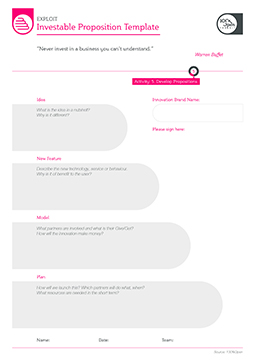Investable Proposition Template
“Never invest in a business you can’t understand.”Warren Buffet


An investable proposition is an idea that has been thought through to a level where our business (or our partners) will commit investment for serious development. Using this process will clarify whether an idea has commercial potential.
The tool is designed to help move forward from a mere idea to a focused plan of action that will bring it to fruition. Once we and our innovation partners have agreed to focus on a particular idea, we will want to work on an Investable Proposition Template. It will be easier to gain attention and attract investment to an idea if you can justify the costs and show a carefully thought-through plan.

Here we record a memorable brand name for our innovation. It is well worth taking this step. Such a brand enables us to communicate the idea easily. A good brand name is a surprisingly effective way of raising the profile of an innovation within an organisation.
If you are using the Investable Proposition Template as part of a group exercise it helps for people to sign and date it. This engenders commitment and serves as a record of who contributed.
What is the idea in a nutshell? Why is it different?
We revisit the definition of the idea from previous work. Is it still fit for purpose? We may have a stack of Idea Frame cards for example or a list of ideas or technologies from a Crowdsourcing Platform. We spend some time defining why it’s different from existing products or services and from other ideas. If it is an incremental innovation clearly distinguish between what remains from previous versions and what we are adding.
Describe the new technology, service or behaviour. Why is it of benefit to the user?
Here we articulate exactly how the innovation works, whether it is a piece of technology, a new service or a new behaviour. It is best to stick to plain, non-technical language here. Also we describe the benefit of this new technology to the user. (Consider the use of Sketch Templates to help visualise the idea).
How will the innovation make money or benefit both partners? Which Open Innovation Model is most appropriate?
In this section we record the nature of the open innovation relationship that we want (see Open Innovation Models and Give|Get). We think about what our offer will be to our potential partner and vice versa. Also we devote some time to thinking through the top level financial aspects of the innovation. This is work that is preparatory for preparing a fuller Business Model Canvas later in the process. So it’s OK to roughly estimate production and distribution costs, price point, profit, sales growth, etc. The point here is to sense check whether we are being wildly optimistic and to list our assumptions.
How will we launch this? Which partners will do what, when? What resources are needed in the short term?
This is the practical part of the template where we look at the plan for getting the innovation to launch. We make a timetable for all the phases about to come: prototyping, creating a business plan, market research, production engineering, finding distribution partners, etc. It will also useful for us to estimate the costs for each of these activities. Filling in the plan will also allow us to see whether we have enough time and money to implement a particular idea or whether other ideas might be cheaper and quicker.
Source: 100%Open
You must be logged in to download this tool
You must be logged in to download this worked example
2014 - 100%OPEN LTD